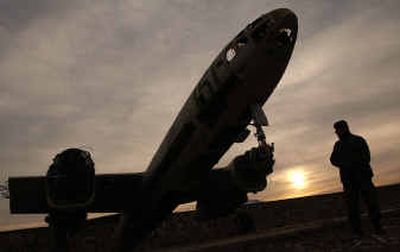Afghanistan asks for Soviet-era warplanes back

KABUL, Afghanistan – Twenty-one years ago, Capt. Mohammed Nabi Karinzai pulled down his visor and roared down the runway in his Soviet-made Su-7 jet for the last time – not for a bombing run against Afghan mujahedeen, but for a dangerous sprint into Western exile.
Karinzai, now in the United States, never returned since that daring flight from then-communist Afghanistan to neighboring Pakistan, except for a brief incursion as part of a guerrilla unit fighting Soviet occupiers in 1984.
But with a new government in Kabul trying to rebuild the country and its defenses after more than two decades of warfare – this time with American rather than Soviet assistance – Afghanistan is finally asking for its planes back.
In all, the Afghan Defense Ministry is seeking the return of 26 aircraft — nine helicopters, five bombers, eight fighters, two trainer jets and two transporters. Officials say 19 are in Pakistan and another seven in Uzbekistan.
“I believe the reaction of the neighbors will be friendly,” Afghanistan’s Foreign Minister Abdullah said Tuesday. Like many Afghans, Abdullah uses only one name.
Some of the planes, like Karinzai’s Sukhoi fighter-bomber, are believed to have been used for dramatic escapes, while others were deliberately moved out of the country to save them from destruction.
Most are Russian-built relics of an arsenal including MiG-21 jet fighters and Mi-24 helicopter gunships built up during the Soviet occupation in the 1980s to combat the resistance of the U.S.-backed mujahedeen, or holy warriors.
Some planes were captured and used by all sides during the civil wars that followed Moscow’s withdrawal. But U.S. bombing destroyed virtually every plane still airworthy in Afghanistan when it ousted the Taliban three years ago.
At present, the Afghan army has 28 aging helicopters and transport planes kept running with spare parts from the cannibalized wrecks that still litter many Afghan air fields. Russia overhauled 11 of the aircraft last year.
It was unclear whether any of the planes in neighboring countries are in any state to join them.
“The life of some of those planes is almost gone,” Afghan Defense Ministry spokesman Gen. Zaher Mohammed Azimi said.
It also remains to be seen if they will be any strategic use to the new Afghanistan.
The ministry this month refounded the air corps as part of a new U.S.-trained Afghan National Army, supposed to reach a strength of 70,000 troops by 2007.
The first objective is to provide airlift for President Hamid Karzai, who travels virtually everywhere – even to the dentist – with the help of U.S. military helicopters.
Maj. Gen. Craig Weston, the U.S. officer responsible for the new army, said Monday that Afghan officials were discussing which aircraft “fit their missions for the future.”
He said it was unclear who would pay for any new planes, or if they would include the kind of aircraft that could replace the American A-10 ground-attack planes or Apache helicopter gunships currently seeking Taliban holdouts in the mountains.
“We would imagine that would be some time in the future,” Weston said.
Karinzai, now 51 and living in Los Angeles, recalled his escape from Afghanistan on Nov. 20, 1983, with pride.
“I knew there were other Russian planes around with air-to-air missiles who would shoot me down, so I told them I had engine trouble and dropped to a low altitude where they wouldn’t see me,” he said in a telephone interview. “They told me to turn back, but they didn’t find me. It was a great feeling.”
If his plane could be found and was airworthy, Karinzai said he would be delighted to fly it home and join the new air corps. But he said Afghanistan would be better off with some new American-made F-16s.
The old bomber should be put in a museum to help explain the suffering of his country under communism.
“I don’t think it would be much use now, but they could collect a piece of Afghan history,” he said. “All the disaster and turmoil that has hurt this country was caused by the Russian invasion.”